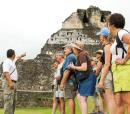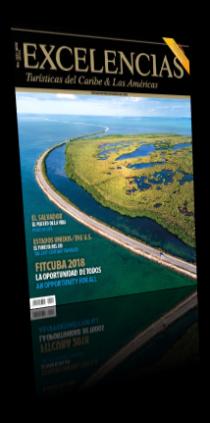- The New-Age Tourist
THESE ARE JUST A FEW KEYS TO TAKING A CLOSER LOOK AT THE 21ST-CENTURY AMERICAN TRAVELER, A TIME IN WHICH THE INDUSTRIAL SOCIETY IS GIVING WAY TO THE SO-CALLED POSTMODERN SOCIETY
Globally speaking, society is transforming at a white-heat's pace. Changes happen so fast that if Rip Van Winkle –the homonymous character from Washington Irving’s story- would have fallen asleep in the late 20th century instead of the days before the start of the U.S. Independence War, and he would waken up twenty years later, he would have found himself living in a society so different that no one would have been able to depict it –not even those armed with such mighty imagination.
In the 21st century, we are witnessing the passage from the industrial society to another one that many authors have labeled the postmodern society, one in which tourism fits in and a new-age tourist pops up. Of course, it’s impossible to determine the exact time when a new social model emerges, a model with a new kind of consumption tacked on it, and that it also includes tourists. Only conventionally speaking we can refer to the postmodern society and postmodern tourism –segmented, resilient and tailor-made- that has arisen with the turn of the new century.
Therefore, we are in a transition period from one social model to another, and from one type of tourism –and tourist- to another. That’s why any effort to define a traveler profile for this century, we simply come across an assortment of different and sometimes conflicting approaches. However, there are some characteristics most people agree upon. For instance, the new traveler prefers customized goods and services and gives top priority to offers, even though he bears prices in mind.
The new-age tourists are also marked by the quest for one-and-only experiences, either ones that let them melt into the place they visit or that trigger adventure-like feelings, a situation other that their daily lives or that derive from their contact with a quasi-untapped natural environment. A study on 2,900 tourists conducted by Rocket Fuel, a marketing and advertising company, and published on the Ostelera Tourism & Hospitality School’s travel blog in April 2016, laid bare that more than half of those who took the poll choose food quality when it comes to handpicking a destination to travel to. For them, having a unique gastronomic experience was a top priority.
Today’s tourists rely constantly on the Internet, especially on the social media, and generally on the latest technologies. They do some research before making up their minds; they peruse the social, economic and cultural context of different destinations and stack them up against conditions and opportunities, let alone transportation offers. The possibilities that digital platforms and smartphone apps have to offer have also made trends shift, so now people plan their trips with plenty of time in advance. The Rocket Fuel study shows that 31 percent of those surveyed have made travel preps even six months in advance.
THE CONTEMPORARY PROFILE
On these premises, let’s try to delve deeper into the contemporary U.S. tourist’s profile. A few keys to unraveling this can be found in the 2011 Portraits of American Travelers, by Ypartnership/Harrison Group, a nationwide poll carried through in March this year and that covered 2,539 American households. Pulso Digital, an Argentine digital newspaper, says the outcomes shed abundant light on the habits of American travelers with annual incomes of $50,000 or more and who have at least moved over 75 miles away from their homes just for pleasure, which included overnight stays in any kind of lodging facility.
According to this research, for these people their time for leisure and vacations is so important that it’s only second best to the passion for their families. As a matter of fact, 64 percent of the total said they were willing to pay for the kind of quality and good service they believe they deserve.
Moreover, the poll revealed that visits to relatives and friends still top the list of travel preferences with 50 percent, followed by family vacations (42 percent). As much as 70 percent, though, had “celebration vacations”. While 89 percent showed interest in sallying forth outside the U.S., only 38 percent of that total did travel overseas –mostly youngsters between 18 and 32 years of age, and people older than 66. And those trips occurred in the Caribbean (34 percent), Europe (33 percent) and Mexico (26 percent). In the meantime, 30 percent of all travelers drove just 50 miles away from home for two days. This “staycation” option is clearly on the rise.
Nearly half of the people surveyed (44 percent) spent time outdoors –beaches, lakes, camping, trekking, mountain climbing, skiing, fishing, golf, adventures or hunting- while 30 percent took a private leisure trip during that timespan, at least six days before traveling. As far as the use of the Internet is concerned, two thirds had visited an online community, travel forum or blog to get information on a number of choices.
These trends remain unchanged in most recent analyses. This is just a small sample: in its “American Traveler Profile” section –these coming figures closed by the end of 2014- Procolombia was aware that U.S. tourists were looking for other sources of information before handpicking a destination. Three years earlier, 40 percent was relying on the Internet, with 53 percent using desktop computers and 22 percent turning to tablets and smartphone apps. The World Wide Web was rapidly catching on as the most sought-after online booking tool among youngsters.
Procolombia dishes out other data: American travelers keep searching for sun-and-beach destinations, especially in the Caribbean, yet more versatile in terms of styles –nightlife, adventures in family, luxury over relaxation and a variety of to-dos, such as scuba diving, yachting and cruises. In the same breath, more American sunbathers are being lured by experimental trips in which they can get in touch with the travel destinations, find more motivation in cultural values, in the people and in once-in-a-lifetime experiences. Around 72 percent was willing to shell out money on that kind of experience rather than on buying things.
On the other hand, the number of “lonesome” travelers is also ratcheting up (58 percent in 2014 compared to little more than 30 percent three years earlier). Across the board, Americans make a couple of trips abroad every year –somewhere between four and five among business travelers- with stays of approximately 17 nights. Tourism is by and large on the top of that list, and they prefer to travel to just one country –with Mexico, Canada, UK and France leading the pack- and then visit two or more destinations inside those countries.
There’s no doubt that today’s U.S. tourists are qualitatively different to the ones that traveled ten years ago; and they differ to European trippers or Chinese travelers because they are influenced by the economic and sociocultural context of their own destination. That context exerts influence on, let’s say, how much they spend on each trip (from $3,200 in 2014 to an estimated $3,500 in 2019, according to figures revealed by Procolombia) and what they eat.
However, either way it’s sound to say that the characteristics they have right now are good enough to label them as the tourists of the 21st century; or maybe to put it even better, as the postmodern tourists “in the works” which are now traipsing down that path to become so.





























































































































